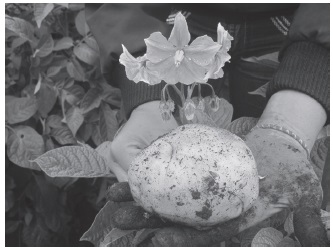Evaluation of calcium carbonate (CaCO3) inclusion in solid-state kinetic fermentation of Solanum tuberosum postharvest waste

Abstract
The objective of this study was to evaluate the pH behavior with CaCO3 inclusions in solid state fermentation of Solanum tuberosum postharvest waste inoculated with a microbial preparation. A supplement was obtained that can be used in animal feed with the following conditions: 89% S. tuberosum, 5% fibrous material (wheat bran); 2% molasses, 1% urea; 2% of the microbial preparation (developed in the research), 0.5% premixed mineral and 0.5% of sodium sulphate. Four treatments were evaluated with 0, 0.25, 0.50 and 0.75% inclusion of CaCO3 to the above mixture at different temperatures (20 and 25ºC), and incubated at different fermentation times (24 and 48 hours). Analysis of variance was carried out according to a completely randomized design with a factorial arrangement (2×2×4) where the factors were two temperatures 20 and 25ºC, two fermentation times 24 and 48 hours and four inclusion levels of calcium carbonate and three replications. A Duncan test was applied for P≤0.05 when necessary. The INFOSTAT statistical package, version 2012, was used for the analysis. The influence of calcium carbonate on pH and MS (P<0.0001) was observed in the study. The pH increased as the percentage of CaCO3 addition supplied for both incubation temperatures increased for 48 hours, according to the values obtained in the fermentation kinetics, with the exception of 25ºC in the highest inclusion level (0.75%). For the DM, an increase in the different inclusion levels of calcium carbonate was observed at a temperature of 20ºC during fermentation although the highest value reached 39.66%. The two protein indicators showed differences for all levels of carbonate inclusion with respect to time and temperatures. However, the crude protein levels were maintained in comparison with those in the microbial preparation, obtaining the highest value with the inclusion of 0.50% CaCO3 at 20ºC, with a marked difference with protein tenors at 25ºC, which were always below the fermentation percentage at 20ºC. The best inclusion of CaCO3 in the fermentation of the postharvest waste of Solanum tuberosum with the microbial preparation was 0.50% at 20ºC, which resulted in an adequate growth of the BAL microorganisms, as reflected in the protein increase.
Keywords
pH, Microbiological analysis, Lactic acid, Bromatology
References
- AOAC. 2005. Official methods of analysis 17th ed. Association of Official Analytical Chemists. Arlington, VA,
- USA.
- Becerra, A. 2008. Aprovechamiento de subproductos de manzana mediante la producción de proteína microbiana con fermentación en estado sólido para la alimentación animal. Tesis de doctorado. Universidad
- Autónoma de Chihuahua, México.
- Borras, L.M, E.C. Valiño y C.E. Rodríguez. 2017. Preparado microbiano con actividad ácido láctica como acelerante biológico en los procesos de fermentación para alimento animal. Rev. Cien. Agri. 14(1), 7-13.
- Di Rienzo, A., F. Casanoves, G. Balzarini, L. Gonzalez, M. Tablada y W. Robledo. 2012. Grupo InfoStat. FCA,
- Universidad Nacional de Córdoba, Argentina. En: http://www.infostat.com.ar; consulta: enero de 2017.
- Dinkci, N., A. Akalın, S. Gonc y G. Unal. 2007. Isocratic Reverse-Phase HPLC for determination of organic acids
- in Kargı Tulum Cheese. Chromatographia (Suppl.) 1, 45-49. Doi: 10.1365/s10337-007-0234-6
- Elías, A., O. Lezcano, P. Lezcano, J. Cordero y L. Quintana. 1990. Reseña descriptiva sobre el desarrollo de una
- tecnología de enriquecimiento proteínico en la caña de azúcar mediante fermentación solida (Saccharina).
- Rev. Cubana Cienc. Agríc. 24(1), 3-12.
- Han, B., V. Ujor, B. Lai, V. Gopalan y C. Ezeji. 2013. Use of proteomic analysis to elucidate the role of calcium inacetone-butanol-ethanol fermentation by Clostridium beijerinckii NCIMB 8052. Appl. Environ. Microbiol.
- (1), 282-293. Doi: 10.1128/AEM.02969-12
- Martínez, F., E. Balciunas, J. Salgado, J. Gonzáles, A. Converti y R. Oliveira. 2003. Lactic acid properties, applications and production: A review. Trends Food Sci. Technol. 30, 70-83. Doi: 10.1016/j.tifs.2012.11.007
- Meir, H. 1986. Laborprälektüre Tierernährung und Futtermittelkunde für Tierproduktion. Verlag DDR, Berlin,
- República Democrática Alemana.
- Mitchell, D.A., M. Berovic y N. Krieger. 2002. Overview of solid state bioprocessing. Biotechnol. Annu. Rev. 8,
- -200. Doi: 10.1016/S1387-2656(02)08009-2
- Montoya, N., I. Pino y H. Correa. 2004. Evaluación de la suplementación con papa (Solanum tuberosum) durante la lactancia en vacas Holstein. Rev. Col. Cienc. Pec. 17(3), 241-249.
- Mundo Pecuario. 2010. Composición nutricional de la papa. En: http://www.mundopecuario.com/tema60/nutrientes_para_monogastricos/papa_harina-262.html;
- consulta: noviembre de 2014.
- Pandey, A., C.R. Soccol, J.A. Rodríguez-León y P. Nigam. 2001. Solid-state fermentation in biotechnology. Fundamentals and applications. Asiatech Publishers, New Delhi, India.
- Pertuz, S. 2012. Composición química y valor nutricional del tubérculo. En:
- http://www.fedepapa.com/wp- content/uploads/pdf/memorias/podernutricional.pdf; consulta: abril de 2017.
- Ramos, J., A. Elías y F. Herrera. 2006. Procesos para la producción de un alimento energético - proteico para
- animales. Efecto de cuatro fuentes energéticas en la fermentación en estado sólido (FES) de la caña de azúcar.
- Rev. Cubana Cien. Agric. 40(1), 51-58.
- Siebald, E., L. Goic y M. Matzner. 2002. Alimentación de rumiantes con papa de desecho. En: Boletín Técnico
- No. 88. Centro Regional de Investigaciones Remehue, Instituto de Investigaciones Agropecuarias (INIA),
- Osorno, Chile.
- Tian, Q., L. Liang y M.J. Dunca. 2015. Enhanced biohydrogen production from sugarcane bagasse by Clostridium thermocellum supplemented with CaCO3. Bioresource Technol. 197, 422-428. Doi: 10.1016/j.
- biortech.2015.08.111
- Yang. P.-B., Y. Tian, Q. Wang y W. Conga. 2015. Effect of different types of calcium carbonate on the lactic acid
- fermentation performance of Lactobacillus lactis. Biochem. Eng. J. 98, 38-46. Doi: 10.1016/j.bej.2015.02.023
